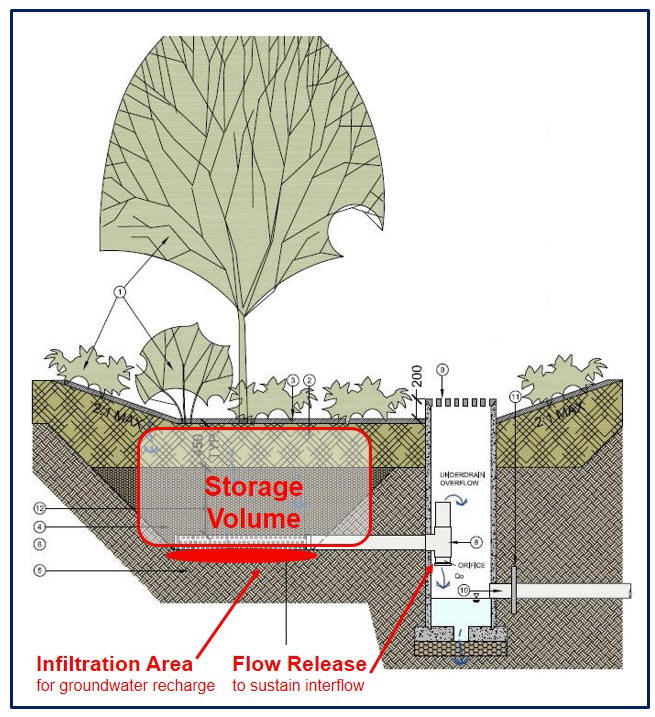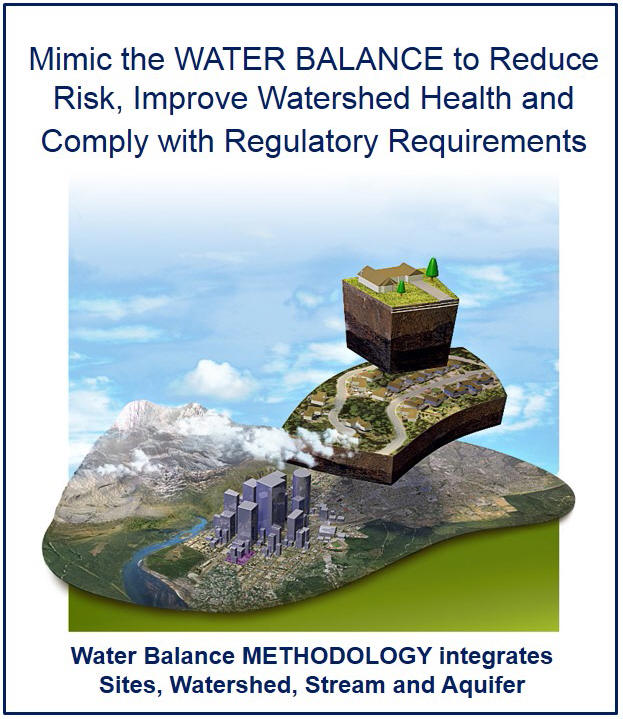Water Balance Express: Restore ‘environmental flows’ in urban streams
Note to Reader:
 Sitelines magazine is a publication of the British Columbia Society of Landscape Architects (BCSLA). Published bi-monthly, BCSLA has a longstanding practice of inviting partner organizations to take on a co-editor role and provide the content for an issue featuring the partner.
Sitelines magazine is a publication of the British Columbia Society of Landscape Architects (BCSLA). Published bi-monthly, BCSLA has a longstanding practice of inviting partner organizations to take on a co-editor role and provide the content for an issue featuring the partner.
The June 2016 issue featured the Partnership for Water Sustainability in BC. This allowed the Partnership to showcase initiatives and tools. Reproduced below is the article co-authored by Jim Dumont and Richard Boase.
Connect Dots: Watershed Targets, Water Balance Express and
BC’s new Water Sustainability Act
“Funded by government to support stream protection and climate change adaptation strategies, the Water Balance Model family of online tools includes the Water Balance Express for Landowners (waterbalance.ca),” wrote Jim Dumont and Richard Boase.
“The Express helps landowners quantify how well rain gardens on their properties slow, sink and spread rainwater runoff and do their share to meet pre-set watershed targets for volume, infiltration and flow. The tool is integrated with Google Maps/Earth and the land use zoning of partner local governments.”
“North Vancouver District undertook the ‘proof of concept’ for Express development as an element of its Hastings Creek watershed plan. Other local government leaders have followed. Each time the tool is enhanced.”
Jim Dumont is the Engineering Applications Authority, Partnership for Water Sustainability in British Columbia. Richard Boase is Environmental Protection Officer, District of North Vancouver. He is also the Partnership’s Vice-President.
To Learn More:
Download In this issue, the Partnership for Water Sustainability in BC presents WATER BALANCE PATHWAY TO A WATER-RESILIENT FUTURE, June 2016, to read the complete set of 9 articles published in Sitelines Magazine.
Stream Health
“The Express is populated with watershed targets determined by applying the Water Balance Methodology. The flow-duration relationship is the cornerstone of the methodology. By maintaining flow-duration, stream erosion is not increased during wet weather and ‘environmental flows’ are sustained during dry weather. When homeowners slow, sink and spread rainwater runoff on their property, urban streams benefit.”
“Protection of streams and fish is an important public expectation, creating a driving force altering our perceptions, aspirations, and treatment of the urban landscape.”
“The new Water Sustainability Act will establish regulations pertaining to ‘environmental flows’ within the next few years. The Express is a key part of the long-term Rainwater Management solution for protecting stream health.”
Rainwater Management
“The purpose of Rainwater Management is to mimic the natural Water Balance and three flow pathways naturally occurring in a watershed. The pathways are surface runoff, seasonal interflow system (shallow horizontal flow), and water stored deep in saturated aquifers which then discharges at some future date. Managing watersheds as an integrated Water Balance system provides a level of assurance that:
 Excess water would not be directed to the ground and would avoid potentially adverse impacts of excessive groundwater levels and discharges in areas lower in the watershed.
Excess water would not be directed to the ground and would avoid potentially adverse impacts of excessive groundwater levels and discharges in areas lower in the watershed.- Summer flows would be maintained with an operating interflow system.
- Downstream properties would not suffer an increased risk of flooding or flood damages.”
“The Water Balance Methodology establishes watershed targets with verifiable calculations and mitigation systems are optimized for both cost and function.”
Water Balance Methodology
“Water Balance Methodology objectives start with the stream and end with the stream, thereby providing a true measure of success for environmental protection:
- Maintain stream flows,
- Improve water quality,
- Provide flood protection,
- Prevent unforeseen impacts,
- Prevent stream erosion, and
- Replace the lost interflow system.”
“The Water Balance Methodology is based upon watershed and stream function and operation. Understanding how precipitation makes its way to the stream allows one to assess how a watershed and stream operate while analytically demonstrating impacts of development and the effectiveness of mitigation works. The table summarizes the natural Water Balance of many west coast watersheds. Clearing and stripping of land eliminates interflow, thereby impacting ‘environmental flows’.”
“Analysis begins with calibration of continuous simulation models using long term climate records, not just selected storms or typical years. The effects of urban development are then estimated and required mitigation measures are sized. Chart 1 (above) shows the flood frequency for one watershed and stream.”
“The results also yield estimates of stream flow durations (Chart 2 below) where the system has been optimized.”
“The rain garden detail illustrates application of the three performance targets for design – the origin of the illustrated detail is the Metro Vancouver Source Control Guidelines.”
To Learn More:
Download a copy, click on Primer on Water Balance Methodology for Protecting Watershed Health. The Primer storyline is structured in five parts:
- Part A: Watershed-Based Approach to Rainwater Management
- Part B: Water Balance Methodology Explained
- Part C: Science Behind the Methodology
- Part D: How to Establish Targets
- Part E: References
For a synopsis of each part, click on the following link to Table 1. Information is presented in a layered fashion to accommodate the interests of a continuum of audiences.
What this Means
“The analytical approach underpinning the Water Balance Methodology is verifiable, and allows the mitigation works (such as rain gardens) to be optimized for size and cost while achieving watershed objectives. The Water Balance Methodology is superior to approaches that rely upon simplistic capture targets unsupported by calculations to demonstrate effectiveness,” concluded Jim Dumont and Richard Boase.

How Performance Targets for Storage, Infiltration and Flow Release are incorporated in a Rain Garden Design (image source: “Stormwater Source Control Design Guidelines 2012 , Metro Vancouver, British Columbia)







